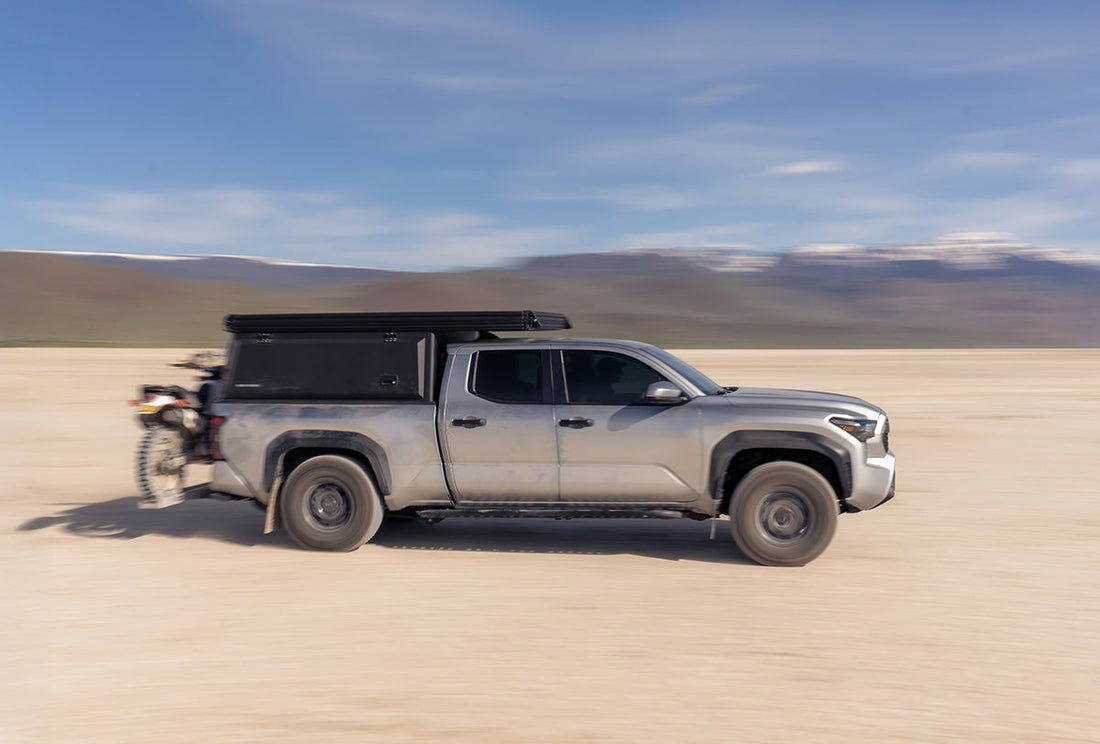In This Article

Why You Need to Seal Your Truck Bed Before Installing a Camper
Dust and water intrusion is a common issue for truck owners—especially those installing canopy campers like the Super Pacific X1. Factory truck beds, including the Toyota Tacoma, have intentional gaps, drains, and airflow spaces that are great for day-to-day hauling but problematic when you're transforming your truck into an all-weather adventure rig. Sealing your bedrails protects your gear, reduces dust infiltration, and helps your camper perform better in harsh weather.

Common Dust and Water Intrusion Points on Toyota Tacomas
Every truck model has its quirks, but Tacomas—especially the Gen 3 models—feature a few known trouble spots that allow dust and water into the bed:
Gaps under the plastic bed rail caps
Quarter-inch openings between the front bed rail and the sidewalls
Drain holes along the floor of the bed
Factory cubbies and exposed holes near the tailgate and wheel wells
- Water can be forced up under the bed rail cap during rain or high-pressure washing, and dust finds its way in through even the smallest gaps when traveling down washboard roads.
Tools and Materials Needed to Seal Your Tacoma Bed Rails
To properly seal your truck bed against dust and water, you'll need:
Butyl tape (for under the bed rail caps)
HVAC foil tape or aluminum tape (for covering holes)
Sikaflex or lap sealant (for a watertight seal)
Closed-cell foam (to fill structural gaps)
Rubbing alcohol and clean rags (for surface prep)
Plastic trim removal tools (to safely pop off the bed rail caps)
Painter’s tape (for a clean finish when sealing with Sikaflex)
Step-by-Step Instructions
1. Pop Off the Plastic Bed Rail Caps
Using plastic trim tools, carefully remove the bed rail caps to expose the rail surface. You’ll likely find evidence of water intrusion along the edge.
2. Clean the Contact Surfaces
Wipe down the exposed surfaces with alcohol and a clean rag. This ensures the butyl and foil tape will properly adhere to the metal, not dust.
3. Apply Butyl Tape Along the Rail
Lay a strip of butyl tape down the full length of the bed rail, especially along the inner edge where water can sneak through. Press firmly to ensure good contact.
4. Replace the Bed Rail Caps
Reinstall the plastic rail caps, pressing them into the butyl tape. This creates a compression seal that blocks dust and water.
5. Add Foil Tape to Internal Gaps
Cover any visible holes along the truck bed sidewalls with HVAC foil tape. Be sure to leave factory floor drains open so any water that does get in has a way out.
6. Seal with Sikaflex
For added protection, run a thin bead of Sikaflex (or similar lap sealant) along the edge where the plastic cap meets the metal bedrail. This adds an extra line of defense, especially in wet climates.
7. Address the Front Bed Gaps
Use closed-cell foam to fill the quarter-inch air gap between the front of the bed and the sidewalls. Cover the foam with butyl tape to seal it off.
8. Reinstall Your Camper with Fresh Gaskets
Before placing the camper on the truck, inspect and replace any old bulb seals. A fresh seal ensures tight compression between the camper and the truck bed.

How This Helps with Camper Installations
If you’re installing a canopy camper—like the Super Pacific X1—sealing your bedrails helps create a cleaner interior environment and reduces the chance of water or dust compromising your gear. Combined with fresh door gaskets and a proper bulb seal under the camper, this process ensures your setup is ready for all-season adventures.
Final Thoughts: Worth the Effort
Every truck model is a little different, but the principles here apply to most trucks. Before you dive in on sealing your Tacoma's bed rails ahead of your wedge camper install focus on the areas where plastic meets metal and where gaps exist between panels. Leverage a few different techniques to block dust, and seal against water intrusion, but don’t completely block the drain holes - if water does get in, it needs somewhere to go.
With a little bit of prep and a few inexpensive materials, you can dramatically reduce how much dust and moisture makes its way into your truckbed or wedge camper, before you have it installed.

X1 Camper: Built for the Elements
The X1 Camper doesn’t care if it’s raining sideways, dumping snow, or baking under a ruthless sun. Born in the wilds of the Pacific Northwest, it’s the only wedge camper built for all four seasons—because when it comes to adventure, there's no such thing as an off-season.

